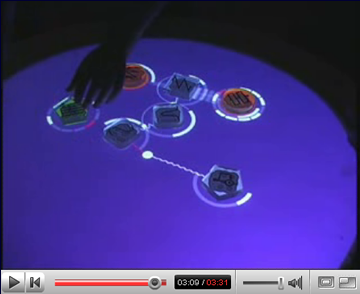Nov 10, 2006
Neuroscientist uses his understanding of the human brain to advance on a popular quiz show
Via Mind Hacks

Ogi Ogas, a doctoral student in cognitive neuroscience at Cognitive and Neural Systems at Boston University, has applied techniques from cognitive psychology to win $500,000 on the show 'Who wants to be a Millionaire?'.
These techniques take advantage of well-studied psychological processes such as such as priming and the structure of associations in memory.
Read how he describes his method in an article appeared on Seed Magazine:
The first technique I drew upon was priming. The priming of a memory occurs because of the peculiar "connectionist" neural dynamics of our cortex, where memories are distributed across many regions and neurons. If we can recall any fragment of a pattern, our brains tend to automatically fill in the rest....
I used priming on my $16,000 question: "This past spring, which country first published inflammatory cartoons of the prophet Mohammed?" I did not know the answer. But I did know I had a long conversation with my friend Gena about the cartoons. So I chatted with [quiz show host] Meredith about Gena. I tried to remember where we discussed the cartoons and the way Gena flutters his hands. As I pictured how he rolls his eyes to express disdain, Gena's remark popped into my mind: "What else would you expect from Denmark?"
16:56 Posted in Research tools | Permalink | Comments (0) | Tags: research tool
Nov 09, 2006
DNART
via LiveScience (thanks to Johnatan Loroni, bioinformatics researcher)
Paul Rothemund, researcher at Caltech, has developed a new tecnique that allows to weave DNA strands into any desired two-dimensional shape or figure, which he calls "DNA origami." According to Rothemund, the technology could one day be used to construct tiny chemical factories or molecular electronics by attaching proteins and inorganic components to DNA circuit boards.
From the press release:
"The construction of custom DNA origami is so simple that the method should make it much easier for scientists from diverse fields to create and study the complex nanostructures they might want," Rothemund explains.
"A physicist, for example, might attach nano-sized semiconductor 'quantum dots' in a pattern that creates a quantum computer. A biologist might use DNA origami to take proteins which normally occur separately in nature, and organize them into a multi-enzyme factory that hands a chemical product from one enzyme machine to the next in the manner of an assembly line."
Reporting in the March 16th issue of Nature, Rothemund describes how long single strands of DNA can be folded back and forth, tracing a mazelike path, to form a scaffold that fills up the outline of any desired shape. To hold the scaffold in place, 200 or more DNA strands are designed to bind the scaffold and staple it together.
Each of the short DNA strands can act something like a pixel in a computer image, resulting in a shape that can bear a complex pattern, such as words or images. The resulting shapes and patterns are each about 100 nanometers in diameter-or about a thousand times smaller than the diameter of a human hair. The dots themselves are six nanometers in diameter. While the folding of DNA into shapes that have nothing to do with the molecule's genetic information is not a new idea, Rothemund's efforts provide a general way to quickly and easily create any shape. In the last year, Rothemund has created half a dozen shapes, including a square, a triangle, a five-pointed star, and a smiley face-each one several times more complex than any previously constructed DNA objects. "At this point, high-school students could use the design program to create whatever shape they desired,'' he says.
Once a shape has been created, adding a pattern to it is particularly easy, taking just a couple of hours for any desired pattern. As a demonstration, Rothemund has spelled out the letters "DNA," and has drawn a rough picture of a double helix, as well as a map of the western hemisphere in which one nanometer represents 200 kilometers.
Link to Live Science report on DNA art
16:34 Posted in Cyberart | Permalink | Comments (0) | Tags: cyberart
Nov 08, 2006
fMRI lie detection test raises ethical issues
Via Mind Hacks
A recent article published in The Washington Post focuses on the socio-ethical implications of the emerging neuroscience of lying. The article reports about a company called No Lie MRI Ltd that claims to use "the first and only direct measure of truth verification and lie detection in human history".
From the article:
No Lie MRI's Web site has proclaimed that the company hopes to revolutionize truth telling in America, offering "objective, scientific, mental evidence, similar to the role in which DNA biological identification is used," to everyone from the FBI, CIA and NSA to the Department of Homeland Security.No Lie is not alone. Its Massachusetts competitor, Cephos Corp., has licensed competing fMRI lie detection technology from the Medical University of South Carolina.
The boundless desire for a way to dig through deception is why political consultant John Zogby, president of Zogby International, expects the new brain scanning devices to be in widespread use in the 2008 presidential election. He can clearly see a demand to discover what voters really think of candidates - and their commercials.
Brain-scan lie detection is now reliable enough that it is starting to be admissible in court.
23:35 Posted in Research tools | Permalink | Comments (0) | Tags: research tools
Ars Virtua Artist-in-Residence (AVAIR)
Re-blogged from Networked performance
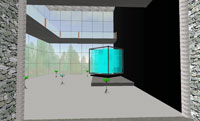
Ars Virtua Artist-in-Residence (AVAIR): Call for Proposals: Deadline November 21, 2006: Ars Virtua Gallery and New Media Center in Second Life is soliciting proposals for its artist-in-residence program. The deadline for submissions is November 21, 2006. Established and emerging artists will work within the 3d rendered environment of Second Life. Each 11-week residency will culminate in an exhibition and a community-based event. Residents will also receive a $400 stipend, training and mentorship.
Ars Virtua Artist-in-Residence (AVAIR) is an extended performance that examines what it means to reside in a place that has no physical location.
Ars Virtua presents artists with a radical alternative to "real life" galleries: 1) Since it does not physically exist artists are not limited by physics, material budgets, building codes or landlords. Their only constraints are social conventions and (malleable-extensible) software. 2) The gallery is accessible 24 hours a day to a potentially infinite number of people in every part of the world simultaneously. 3) Because of the ever evolving, flexible nature of Second Life the "audience" is a far less predictable variable than one might find a Real Life gallery. Residents will be encouraged to explore, experiment with and challenge traditional conventions of art making and distribution, value and the art market, artist and audience, space and place.
Application Process: Artists are encouraged to log in to Second Life and create an avatar BEFORE applying. Download the application requirements here: http://arsvirtua.com/residence. Finalists will be contacted for an interview. Interviews will take place from November 28-30.
23:13 Posted in Cyberart, Virtual worlds | Permalink | Comments (0) | Tags: cyberart, virtual worlds
Body as musical instrument
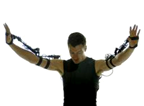
Dance and music go together. Intuitively, we know they have common elements, and while we cannot even begin to understand what they are or how they so perfectly complement one another, it is clear that they are both are an expression of something deep and fundamental within all human beings. Both express things that words cannot - beyond intellect, they are perhaps two of the fundamental building blocks of human expression, common to the souls of all people. Which is why when we saw this machine which links the two, we knew there was something special brewing.
The GypsyMIDI is a unique instrument for motion-capture midi control - a machine that enables a human being to become a musical instrument - well, a musical instrument controller to be exact, or a bunch of other things depending on your imagination.
Read the full post on NP
23:05 Posted in Cyberart | Permalink | Comments (0) | Tags: creativity and computers
Alert driver fatigue wrist device
Via Medgadget
A future concept designed for the AA, this flexible rubber device uses motion combined with reaction time to determine whether or not you are suffering from driver fatigue. The device comunicates with an RFID tag positioned in your car and only starts to detect whether you are tired when you are in your car. The device can be bent to fit your wrist, and has memory to stay in position, to ensure it will not fall off.
Designer: Daniel Ruffle
22:55 Posted in Wearable & mobile | Permalink | Comments (0) | Tags: wereable, mobile
Nov 07, 2006
SHOJI: Symbiotic Hosting Online Jog Instrument
From Pink Tentacle
Symbiotic Hosting Online Jog Instrument (SHOJI) is a system that monitors the feelings and behavior of the people in the room and relays the mood data to remote terminals where it is displayed as full-colored LED light.
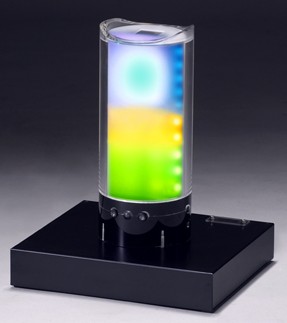
In addition to constantly measuring the room’s environmental conditions, SHOJI terminals can detect the presence and movement of people, body temperature, and the nature of the activity in the room.
Read the full post on Pink Tentacle
23:21 Posted in Emotional computing | Permalink | Comments (0) | Tags: emotional computing
[meme.garden]
re-blogged from Networked Performance

[meme.garden] by Mary Flanagan, Daniel Howe, Chris Egert, Junming Mei, and Kay Chang [meme.garden] is an Internet service that blends software art and search tool to visualize participants' interests in prevalent streams of information, encouraging browsing and interaction between users in real time, through time. Utilizing the WordNet lexical reference system from Princeton University, [meme.garden] introduces concepts of temporality, space, and empathy into a network-oriented search tool. Participants search for words which expand contextually through the use of a lexical database. English nouns, verbs, adjectives and adverbs are organized into floating synonym "seeds," each representing one underlying lexical concept. When participants "plant" their interests, each becomes a tree that "grows" over time. Each organism's leaves are linked to related streaming RSS feeds, and by interacting with their own and other participants' trees, participants create a contextual timescape in which interests can be seen growing and changing within an environment that endures.
The [meme.garden] software was created by an eclectic team of artists and scientists: Mary Flanagan, Daniel Howe, Chris Egert, Junming Mei, and Kay Chang.
23:10 Posted in Cyberart | Permalink | Comments (0) | Tags: cyberart
The future of music experience
check out this youtube video showing "reactable", an amazing music instrument with a tangible interface
23:00 Posted in Future interfaces | Permalink | Comments (0) | Tags: future interfaces
Efficacy of biofeedback for migraine
Efficacy of biofeedback for migraine: A meta-analysis.
Pain. 2006 Nov 1;
Authors: Nestoriuc Y, Martin A
In this article, we meta-analytically examined the efficacy of biofeedback (BFB) in treating migraine. A computerized literature search of the databases Medline, PsycInfo, Psyndex and the Cochrane library, enhanced by a hand search, identified 86 outcome studies. A total of 55 studies, including randomized controlled trials as well as pre-post trials, met our inclusion criteria and were integrated. A medium effect size (d =0.58, 95% CI=0.52, 0.64) resulted for all BFB interventions and proved stable over an average follow-up phase of 17 months. Also, BFB was more effective than control conditions. Frequency of migraine attacks and perceived self-efficacy demonstrated the strongest improvements. Blood-volume-pulse feedback yielded higher effect sizes than peripheral skin temperature feedback and electromyography feedback. Moderator analyses revealed BFB in combination with home training to be more effective than therapies without home training. The influence of the meta-analytical methods on the effect sizes was systematically explored and the results proved to be robust across different methods of effect size calculation. Furthermore, there was no substantial relation between the validity of the integrated studies and the direct treatment effects. Finally, an intention-to-treat analysis showed that the treatment effects remained stable, even when drop-outs were considered as nonresponders.
22:49 Posted in Biofeedback & neurofeedback | Permalink | Comments (0) | Tags: biofeedback
TagCrowd
From the TagCrowd blog
TagCrowd is a web application for visualizing word frequencies in any user-supplied text by creating what is popularly known as a tag cloud.
Today, tag clouds are primarily used for navigation and visualization on websites that employ user-generated metadata (tags) as a categorization scheme. (Flickr is a good example.)
TagCrowd is trying to do something different.
When we look at a tag cloud, we see not only a richly informative, beautiful image that communicates much in a single glance. We see a whole new approach to text.
Potential uses for tag clouds extend far outside the online realm: as topic summaries for written works, as name tags for conferences, as resumes in a single glance, as analyses for survey data, as visual poetry; the list goes on.
In the future, TagCrowd will develop into a suite of experimental tools and tutorials that empower social and collaborative uses for tag clouds and related visualizations.
00:28 Posted in Information visualization | Permalink | Comments (0) | Tags: information visualization
Talking space
From Textually.org (via Designboom)
Yang Shi Wei and Shawn Wein Shin from Taiwan have designed "Talking Space", a lampshade that creates a space to close off voice during phone conversations

In the designers' own words:
People enjoy the feeling at party. We always hear much sound about laugh, games, music or play... It's good!! Let we relax and excite. Everything is fine. Playing with your friend. But now, your phone is ringing. It maybe tells an important message to you. Can you talk with the other side on noisy place? You need to leave, and try to find another place to close off voice. Going to outside ?! It's just one of way to solve problems. Have another way?
00:17 Posted in Wearable & mobile | Permalink | Comments (0) | Tags: mobile phones
SLAM - Mobile social networking from Microsoft Research
Via LADS
SLAM is a mobile based social networking application deveoped by Microsoft Research’s Community Technologies Group, which enables lightweight, group-centric real-time communication, photo-sharing and location awareness.

From LADS:
From the user perspective, “Slam” means a group of people with whom you can share you exchange messages and share photos easily through your mobile phone. Slam works on group level, which means that any messages sent to a Slam gets delivered to all the members in the group. To use Slam you need to install the Slam application on your Windows Mobile based devices and need a unlimited data plan. So any messages sent from your smart phone will be over HTTP instead of using SMS. If you don’t have Windows based device, you can still communicate with your Slams through SMS, since each Slam has a different phone number to enable SMS delivery.
Slam delivers a pretty impressive feature set on the smart phones. Besides exchanging messages, users can view private and public Slams, create Slam, invite people to an existing Slam, join Slams, view Slam members, view and upload photos, manage their Slams, and view unread messages. While viewing a member profile Slam also indicates if you the user has any an intersecting Slam group with you.
One of the best features Slam team is working on is to provide location information of people in your Slam group. Once group members set their privacy level to allow appropriate Slam groups to view their location information, Slam maps the location information onto a Windows Live map on your mobile. This feature is more of a proof of concept and works only on few phone including Audiovox 5600, I-Mate Sp3 and i-Mate SP5 for some of the Seattle users of Cingular/AT&T and T-Mobile.
Visit also the Microsoft Slam Team Blog
00:00 Posted in Locative media, Social Media | Permalink | Comments (0) | Tags: social networks, locative media
Nov 06, 2006
Iris recognition technology for mobile phones
Re-blogged from Pink Tentacle
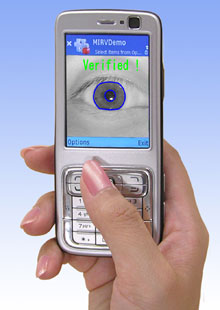
Oki Electric announced the development of iris recognition technology for camera-equipped mobile phones. Unlike Oki’s previous iris recognition technology that relies on infrared cameras for the iris scan, the new technology uses ordinary cellphone cameras. With plans to make the technology commercially available in March 2007, Oki hopes to boost the security of cellphone payment systems. According to Oki, any camera-equipped cellphone or PDA can perform iris recognition once the special software is installed. Identification accuracy is said to be high, with only 1 in 100,000 scans resulting in error, and the system can tell the difference between flesh-and-blood eyes and photographs.
23:23 Posted in AI & robotics, Wearable & mobile | Permalink | Comments (0) | Tags: artificial intelligence, mobile phones
Dopamine used to prompt nerve tissue to regrow
Via Medgadget

Georgia Tech/Emory researchers are testing how to use dopamine to design polymer that could help damaged nerves reconnect. Their discovery might lead to the development of new therapies for a range of central and peripheral nervous system disorders:
The discovery is the first step toward the eventual goal of implanting the new polymer into patients suffering from neurological disorders, such as Alzheimer's, Parkinson's or epilepsy, to help repair damaged nerves. The findings were published online the week of Oct. 30 in the Proceedings of the National Academy of Sciences (PNAS).
"We showed that you could use a neurotransmitter as a building block of a polymer," said Wang. "Once integrated into the polymer, the transmitter can still elicit a specific response from nerve tissues."
The "designer" polymer was recognized by the neurons when used on a small piece of nerve tissue and stimulated extensive neural growth. The implanted polymer didn't cause any tissue scarring or nerve degeneration, allowing the nerve to grow in a hostile environment post injury.
When ready for clinical use, the polymer would be implanted at the damaged site to promote nerve regeneration. As the nerve tissue reforms, the polymer degrades.
Wang's team found that dopamine's structure, which contains two hydroxyl groups, is vital for the material's neuroactivity. Removing even one group caused a complete loss of the biological activity. They also determined that dopamine was more effective at differentiating nerve cells than the two most popular materials for culturing nerves -- polylysine and laminin. This ability means that the material with dopamine may have a better chance to successfully repair damaged nerves.
The success of dopamine has encouraged the team to set its sights on other neurotransmitters.
"Dopamine was a good starting point, but we are looking into other neurotransmitters as well," Wang said.
The team's next step is to verify findings that the material stimulates the reformation of synapses in addition to regrowth.
23:14 Posted in Neurotechnology & neuroinformatics | Permalink | Comments (0) | Tags: neurotechnology
New test superior to Mini Mental Status Examination
Via Medline
Geriatricians from Saint Louis University have developed a new test for diagnosing dementia - the Saint Louis University Mental Status Examination (SLUMS) - which appears to be more effective than the widely-used Mini Mental Status Examination (MMSE).
The study has been published in the current issue of the American Journal of Geriatric Psychiatry (14:900-910, November 2006)
From the news release
"This early detection of mild neurocognitive disorder by the SLUMS offers the opportunity for the clinicians to begin early treatment as it becomes available," says Syed Tariq, M.D., lead author and associate professor of geriatric medicine at Saint Louis University.
John Morley, M.D., director of the division of geriatric medicine at Saint Louis University, created the SLUMS to screen more educated patients and to detect early cognitive problems.
"There are potential treatments available and they slow down the progression of the disease," says Morley, who is a coinvestigator. "The earlier you treat, the better people seem to do. But families go through denial and sometimes miss diagnosing dementia until its symptoms are no longer mild."
The researchers found the new screening tool developed by SLU detects early cognitive problems missed by the MMSE.
"The Mini Mental Status Examination has limitations, especially with regard to its use in more educated patients and as a screen for mild neurocognitive disorder," Tariq says.
It takes a clinician about seven minutes to administer the SLUMS, which supplements the Mini Mental Status Examination by asking patients to perform tasks such as doing simple math computations, naming animals, recalling facts and drawing the hands on a clock.
23:00 Posted in Research tools | Permalink | Comments (0) | Tags: research tools
Boosting slow oscillations during sleep potentiates memory
Boosting slow oscillations during sleep potentiates memory
Nature advance online publication 5 November 2006
Authors: Lisa Marshall, Halla Helgadóttir, Matthias Mölle and Jan Born
There is compelling evidence that sleep contributes to the long-term consolidation of new memories. This function of sleep has been linked to slow (<1 Hz) potential oscillations, which predominantly arise from the prefrontal neocortex and characterize slow wave sleep. However, oscillations in brain potentials are commonly considered to be mere epiphenomena that reflect synchronized activity arising from neuronal networks, which links the membrane and synaptic processes of these neurons in time. Whether brain potentials and their extracellular equivalent have any physiological meaning per se is unclear, but can easily be investigated by inducing the extracellular oscillating potential fields of interest. Here we show that inducing slow oscillation-like potential fields by transcranial application of oscillating potentials (0.75 Hz) during early nocturnal non-rapid-eye-movement sleep, that is, a period of emerging slow wave sleep, enhances the retention of hippocampus-dependent declarative memories in healthy humans. The slowly oscillating potential stimulation induced an immediate increase in slow wave sleep, endogenous cortical slow oscillations and slow spindle activity in the frontal cortex. Brain stimulation with oscillations at 5 Hz—another frequency band that normally predominates during rapid-eye-movement sleep—decreased slow oscillations and left declarative memory unchanged. Our findings indicate that endogenous slow potential oscillations have a causal role in the sleep-associated consolidation of memory, and that this role is enhanced by field effects in cortical extracellular space.
22:35 Posted in Brain training & cognitive enhancement | Permalink | Comments (0) | Tags: cognitive enhancement
Nov 05, 2006
A strategy for computer-assisted mental practice in stroke rehabilitation
A strategy for computer-assisted mental practice in stroke rehabilitation.
Neurorehabil Neural Repair. 2006 Dec;20(4):503-7
Authors: Gaggioli A, Meneghini A, Morganti F, Alcaniz M, Riva G
OBJECTIVE: To investigate the technical and clinical viability of using computer-facilitated mental practice in the rehabilitation of upper-limb hemiparesis following stroke. DESIGN: A single-case study. SETTING: Academic-affiliated rehabilitation center.Participant. A 46-year-old man with stable motor deficit of the upper right limb following subcortical ischemic stroke.Intervention. Three computer-enhanced mental practice sessions per week at the rehabilitation center, in addition to usual physical therapy. A custom-made virtual reality system equipped with arm-tracking sensors was used to guide mental practice. The system was designed to superimpose over the (unseen) paretic arm a virtual reconstruction of the movement registered from the nonparetic arm. The laboratory intervention was followed by a 1-month home-rehabilitation program, making use of a portable display device. MAIN OUTCOME MEASURES: Pretreatment and posttreatment clinical assessment measures were the upper-extremity scale of the Fugl-Meyer Assessment of Sensorimotor Impairment and the Action Research Arm Test. Performance of the affected arm was evaluated using the healthy arm as the control condition. RESULTS: The patient's paretic limb improved after the first phase of intervention, with modest increases after home rehabilitation, as indicated by functional assessment scores and sensors data. CONCLUSION: Results suggest that technology-supported mental training is a feasible and potentially effective approach for improving motor skills after stroke.
22:29 Posted in Cybertherapy, Mental practice & mental simulation | Permalink | Comments (0) | Tags: mental practice, cybertherapy
US Presidential Speeches Tag Cloud 1776-2006
Re-blogged from IFTF's future now
A very interesting way to see the changes in rhetoric over time (you can move the slider around to see trends in word usage)

The above tag cloud shows the popularity, frequency, and trends in the usages of words within speeches, official documents, declarations, and letters written by the Presidents of the US between 1776 - 2006 AD.
The dataset consists of over 360 documents downloaded from Encyclopedia Britannica and ThisNation.com.
22:15 Posted in Information visualization | Permalink | Comments (0) | Tags: information visualization
Nano-optical switches to restore sight?
From Emerging Technology Trends
Californian researchers are using light to control biological nanomolecules and proteins. They think it's possible to put some of their nano-photoswitches in the cells of the retina, restoring light sensitivity in people with degenerative blindness such as macular degeneration...
Read the full article
22:11 Posted in Neurotechnology & neuroinformatics | Permalink | Comments (0) | Tags: neuroinformatics, enhanced cognition








